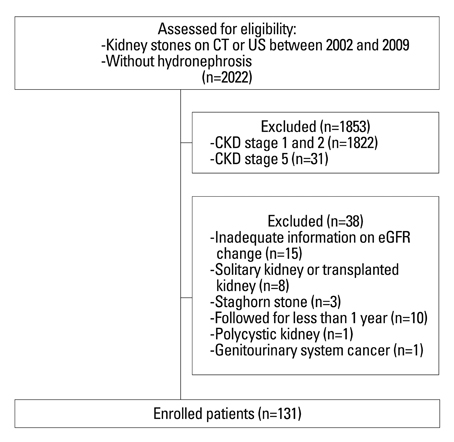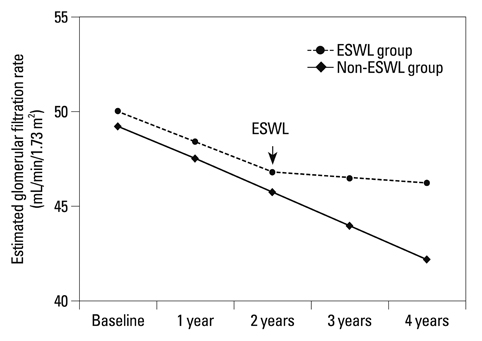Yonsei Med J.
2012 Jul;53(4):708-714. 10.3349/ymj.2012.53.4.708.
Removal of Kidney Stones by Extracorporeal Shock Wave Lithotripsy Is Associated with Delayed Progression of Chronic Kidney Disease
- Affiliations
-
- 1Division of Nephrology, Department of Internal Medicine, Yonsei University College of Medicine, Seoul, Korea. khchoi6@yuhs.ac
- KMID: 1716867
- DOI: http://doi.org/10.3349/ymj.2012.53.4.708
Abstract
- PURPOSE
This study aimed to elucidate whether stone removal by extracorporeal shock wave lithotripsy (ESWL) is associated with delayed chronic kidney disease (CKD) progression.
MATERIALS AND METHODS
We conducted a retrospective analysis of 131 nephrolithiasis patients with stage 3 and 4 CKD. We collected baseline clinical and laboratory data, kidney stone characteristics, and history of receiving ESWL. We classified study patients into two groups according to whether they underwent ESWL or not (Non-ESWL group vs. ESWL group). We initially compared annual estimated glomerular filtration rate (eGFR) changes of Non-ESWL group with those of ESWL group before undergoing ESWL. In the next step, we sought to compare annual eGFR changes in the same patients before and after ESWL. Finally, we compared annual eGFR changes between success and failure groups among patients undergoing ESWL.
RESULTS
The mean age of the patients was 62 years and 72.5% were male. The mean observation period was 3.2 years. Non-ESWL group and ESWL group before undergoing ESWL showed similar annual eGFR changes (-1.75+/-6.5 vs. -1.63+/-7.2 mL/min/1.73 m2/year, p=0.425). However, eGFR declined slower after undergoing ESWL than before ESWL (annual eGFR changes, -0.29+/-6.1 vs. -1.63+/-7.2 mL/min/1.73 m2/year, p<0.05). In addition, among patients in ESWL group, eGFR declined faster in the failure group than in the success group (annual eGFR change, -1.01+/-4.7 vs. -0.05+/-5.2 mL/min/1.73 m2/year, p<0.05).
CONCLUSION
Our results suggest that stone removal by ESWL is associated with delayed deterioration of renal function in CKD patients with nephrolithiasis.
Keyword
MeSH Terms
Figure
Reference
-
1. Romero V, Akpinar H, Assimos DG. Kidney stones: a global picture of prevalence, incidence, and associated risk factors. Rev Urol. 2010. 12:e86–e96.2. Frymoyer PA, Scheinman SJ, Dunham PB, Jones DB, Hueber P, Schroeder ET. X-linked recessive nephrolithiasis with renal failure. N Engl J Med. 1991. 325:681–686.
Article3. Holmgren K, Danielson BG, Fellström B. Infection-induced urinary calculi and renal failure. Scand J Urol Nephrol. 1987. 21:219–223.
Article4. Assimos DG, Leslie SW, Ng C, Streem SB, Hart LJ. The impact of cystinuria on renal function. J Urol. 2002. 168:27–30.
Article5. Singh M, Chapman R, Tresidder GC, Blandy J. The fate of the unoperated staghorn calculus. Br J Urol. 1973. 45:581–585.
Article6. U S Renal Data System. Atlas of Chronic Kidney Disease and End-Stage Renal Disease in the United States. USRDS 2010 Annual Data Report. 2010. Bethesda, MD: National Institutes of Health, National Institute of Diabetes and Digestive and Kidney Diseases.7. Gillen DL, Worcester EM, Coe FL. Decreased renal function among adults with a history of nephrolithiasis: a study of NHANES III. Kidney Int. 2005. 67:685–690.
Article8. Rule AD, Bergstralh EJ, Melton LJ 3rd, Li X, Weaver AL, Lieske JC. Kidney stones and the risk for chronic kidney disease. Clin J Am Soc Nephrol. 2009. 4:804–811.
Article9. Vupputuri S, Soucie JM, McClellan W, Sandler DP. History of kidney stones as a possible risk factor for chronic kidney disease. Ann Epidemiol. 2004. 14:222–228.
Article10. Saucier NA, Sinha MK, Liang KV, Krambeck AE, Weaver AL, Bergstralh EJ, et al. Risk factors for CKD in persons with kidney stones: a case-control study in Olmsted County, Minnesota. Am J Kidney Dis. 2010. 55:61–68.
Article11. National Kidney Foundation. K/DOQI clinical practice guidelines for chronic kidney disease: evaluation, classification, and stratification. Am J Kidney Dis. 2002. 39:2 Suppl 1. S1–S266.12. LeRoy AJ. Diagnosis and treatment of nephrolithiasis: current perspectives. AJR Am J Roentgenol. 1994. 163:1309–1313.
Article13. Evan AP, Willis LR, Connors B, Reed G, McAteer JA, Lingeman JE. Shock wave lithotripsy-induced renal injury. Am J Kidney Dis. 1991. 17:445–450.
Article14. Evan AP, Willis LR, Lingeman JE, McAteer JA. Renal trauma and the risk of long-term complications in shock wave lithotripsy. Nephron. 1998. 78:1–8.
Article15. Willis LR, Evan AP, Connors BA, Reed G, Fineberg NS, Lingeman JA. Effects of extracorporeal shock wave lithotripsy to one kidney on bilateral glomerular filtration rate and PAH clearance in minipigs. J Urol. 1996. 156:1502–1506.
Article16. Newman R, Hackett R, Senior D, Brock K, Feldman J, Sosnowski J, et al. Pathologic effects of ESWL on canine renal tissue. Urology. 1987. 29:194–200.
Article17. Sheir KZ, Gad HM. Prospective study of the effects of shock wave lithotripsy on renal function: role of post-shock wave lithotripsy obstruction. Urology. 2003. 61:1102–1106.
Article18. Sheir KZ, Elhalwagy SM, Abo-Elghar ME, Ismail AM, Elsawy E, El-Diasty TA, et al. Evaluation of a synchronous twin-pulse technique for shock wave lithotripsy: a prospective randomized study of effectiveness and safety in comparison to standard single-pulse technique. BJU Int. 2008. 101:1420–1426.
Article
- Full Text Links
- Actions
-
Cited
- CITED
-
- Close
- Share
- Similar articles
-
- A Case Report of Acute Kidney Injury after Extracorporeal Shockwave Lithotripsy
- Clinical Experience of Extracorporeal Shock Wave Lithotripsy with the Dornier Compact Delta(R)
- Clinical Experience with Extracorporeal Shock Wave Lithotripsy for Nephrocalcinosis in Medullary Spongy Kidney: A Report of 7 Cases
- The effect of double-J stent in extracorporeal shock wave lithotripsy monotherapy of staghorn calculi
- Clinical Experience with EDAP LT-01+ Extracorporeal Shock Wave Lithotripsy for Radiolucent Stones: A Report of 27 Cases



